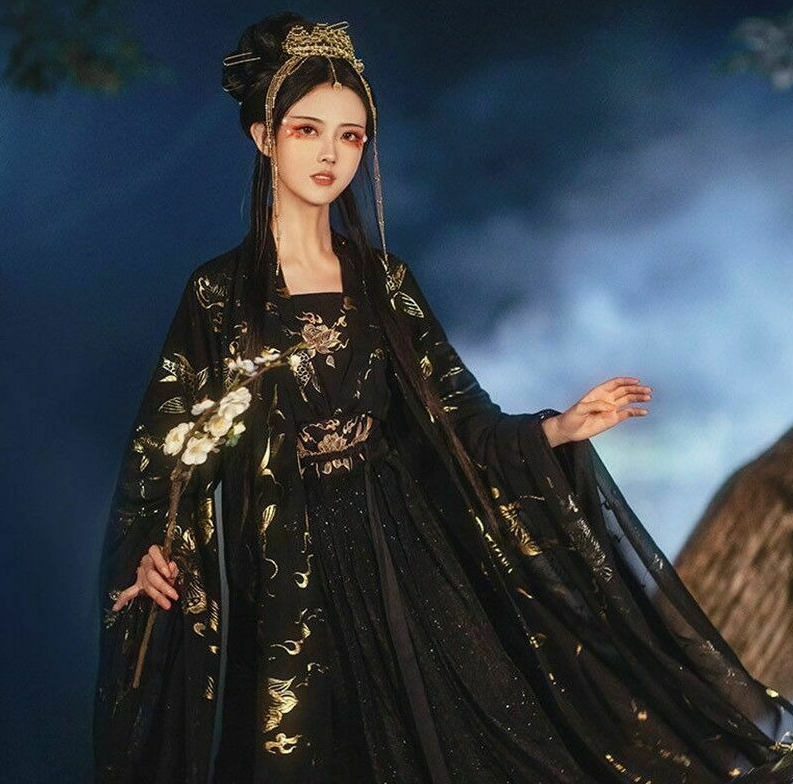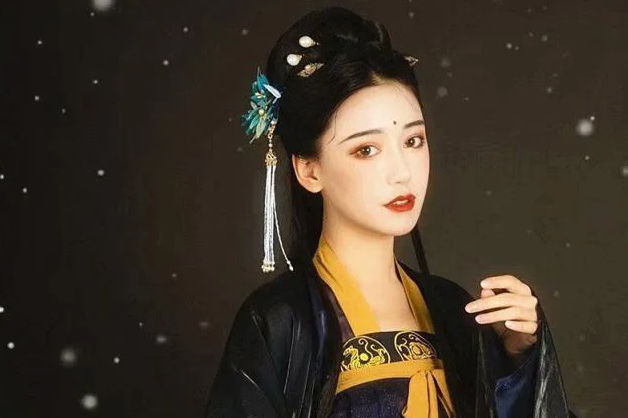The black Hanfu symbolizes water, neutrality, modesty, and has historical, ceremonial, and cultural significance.
Historical Context
The evolution of Hanfu over the dynasties
Hanfu, the traditional dress of the Han Chinese, has experienced significant changes through China’s various dynasties. During the Qin Dynasty, Hanfu was relatively simple, reflecting the strict, utilitarian ethos of the era. Moving forward to the Han Dynasty, Hanfu became more varied, with distinct styles for different occasions and social classes.
During the Tang Dynasty, one of China’s golden ages, Hanfu experienced a flourish of styles. The popular styles included the “Round-collared Robe” and the “Shenyi”, with women’s attire being particularly vibrant, often adorned with wide sleeves and intricate embroidery. The Song Dynasty introduced the “Beizi”, a long, loose gown, which became the popular style for women during this period.
The Ming Dynasty brought changes such as the rise of the “Zhiju”, a straight-sleeved robe.

Importance of color symbolism in ancient China
Colors in ancient China held profound symbolic meanings and were often reflective of societal beliefs and philosophies. Red, for instance, symbolized good fortune and happiness.
Green symbolized growth and harmony, often linked to spring and the wood element. Blue was associated with the winter season and had connections to immortality. Black, central to our discussion, was tied to water and symbolized the mysterious, the infinite, and sometimes the north direction. White, on the other hand, had associations with purity and innocence but was also a color of mourning.
It’s fascinating to note that during various dynasties, the preferred color choices for Hanfu reflected not just personal taste but also societal values, cosmological beliefs, and even political dynamics of the time.
Symbolism of the Color Black in Chinese Culture
General cultural associations of black
In Chinese culture, the color black has diverse meanings and associations. Traditionally, black is often seen as a representation of water, one of the fundamental elements. It also stands for the winter season, cold, and the north direction. In ancient texts and philosophies, black frequently symbolized the mysterious and the infinite, representing depth, both literally and metaphorically.
While in some cultures black may be associated predominantly with negative connotations such as death or evil, in Chinese culture, it has a balanced representation. For instance, in the world of Yin and Yang, black represents Yin – which is passive, receptive, and feminine. This is not a negative representation, but rather a complementary one, where Yin and Yang together create harmony and balance.
The five-element theory and its connection to black
The Five Elements Theory or “Wu Xing” is central to traditional Chinese thought, encompassing medicine, philosophy, and more. These elements are Wood (木 mù), Fire (火 huǒ), Earth (土 tǔ), Metal (金 jīn), and Water (水 shuǐ).
Water, represented by the color black, embodies various characteristics. In its nature, water is adaptive, flowing wherever it finds a path. This adaptability and resilience are traits associated with those born in the “Water” years according to Chinese astrology. Moreover, as water nourishes and supports life, black, by extension, signifies life-supporting qualities.
In ancient Chinese architecture and design, black was used in specific contexts to represent this water element, offering a sense of balance in a space. Just as water can be both calm and turbulent, black in Chinese aesthetics can evoke a sense of calm depth or, when contrasted, a dynamic energy.
Black Hanfu in Different Dynasties
Tang Dynasty: Fashion and symbolism
The Tang Dynasty stands out as one of the most prosperous periods in Chinese history, a golden age of culture, art, and fashion. The Hanfu of this era displayed an unprecedented elegance and variety. In terms of materials, silk, known for its smooth texture and luxurious sheen, dominated the Hanfu fashion scene. For the elite, black Hanfu made from high-quality silk was a symbol of wealth and status.
Black, during the Tang Dynasty, was not just a color but carried significant symbolism. While it primarily represented the water element, it also was a color that signified neutrality and modesty. Royals and nobles would often wear black Hanfu during specific ceremonies or diplomatic meetings, suggesting a sense of neutrality and impartiality.
Song Dynasty: Subtle elegance in design
As China transitioned into the Song Dynasty, the style and design of Hanfu underwent subtle changes.
This period saw a surge in the use of more delicate materials and finer craftsmanship. Song Dynasty’s black Hanfu often featured nature-inspired designs like chrysanthemums, plum blossoms, and bamboo, symbolizing nobility, perseverance, and resilience, respectively.
Ming Dynasty: Changes and adaptations
The Ming Dynasty heralded a return to Han Chinese dominance, and with it came changes in fashion. The earlier designs were further refined, and there was a move towards simplicity and practicality. While the black Hanfu remained a staple, its designs became more straightforward, with emphasis on cut and fit.
In terms of materials, while silk remained popular, cotton started to gain prominence due to its comfort and breathability, especially in warmer regions. Black Hanfu made of cotton became more accessible to the common folk.
Situations for Wearing Black Hanfu
Ceremonial and formal events
Black Hanfu, with its deep and neutral hue, often becomes the clothing of choice for various ceremonial and formal events. Historically, Chinese officials, scholars, and other dignitaries donned black Hanfu during significant events, such as the emperor’s audience or diplomatic gatherings. The color black signified impartiality, stability, and respect.
In terms of materials, for these occasions, black Hanfu made from the finest silk, often embellished with minimalistic embroidery, was chosen. Quality was paramount; thus, the silk’s sheen, softness, and texture could differentiate a high-ranking official’s robe from a lower-ranking one.
Mourning and funerary customs
In Chinese culture, white primarily represents mourning. However, black also holds a significant place in mourning and funerary customs. In some regions and traditions, family members of the deceased wear black Hanfu as a sign of their grieving.
During these times, the material of the Hanfu would be simpler, often made of coarse cotton, to symbolize the somber mood.
Artistic and theatrical performances
Chinese opera and traditional theatrical performances have a rich history of employing colors for symbolic storytelling.
In terms of design, theatrical black Hanfu might be more elaborate than everyday wear. Embroideries, patterns, and accessories would be used to accentuate the character’s role and personality. For example, a black Hanfu adorned with silver or white patterns might signify a character with a hidden or dual nature.
In the realm of dance and other artistic performances, black Hanfu allows for a stark contrast against colorful backdrops, ensuring the performer stands out and the audience’s focus remains undivided.
Influence of External Cultures
Interaction with neighboring cultures and their influence on black Hanfu
China, with its vast expanse and strategic position, has always been at the crossroads of various civilizations. Through the ages, the Silk Road played a pivotal role in facilitating exchanges between China and its neighbors, including Central Asia, Persia, and even the Roman Empire.
These interactions led to the incorporation of foreign design elements into traditional Chinese clothing.
Furthermore, patterns and motifs popular in Persia and other western regions started appearing on black Hanfu. The intricate vine and floral motifs, which were prevalent in Persian tapestries, found their way onto the silken fabrics of black Hanfu worn by Chinese elites.

Modern interpretations and fusion styles
With globalization and the increasing interconnectedness of today’s world, the Hanfu, like many traditional dresses, has seen a fusion with modern aesthetics and foreign styles. Contemporary fashion designers, looking for inspiration from the past and from diverse cultures, have created unique, hybrid designs.
Black Hanfu today might feature a blend of traditional Chinese embroidery with elements reminiscent of western gowns or Japanese kimono styles. The slim-fit silhouette of modern dresses combined with the flowing elegance of traditional Hanfu has become a popular trend among the youth.
Contemporary Relevance
Black Hanfu in modern fashion
In the realm of modern fashion, black Hanfu has surged back into popularity, drawing both from its traditional roots and integrating modern styles. The elegance of black, combined with the timeless grace of Hanfu, makes it a preferred choice for many occasions, from formal events to casual get-togethers.
Top fashion designers in China and internationally often present collections featuring black Hanfu, showcasing its versatility. Made from a mix of materials ranging from the traditional silk to modern fabrics like rayon and polyester, these outfits strike a balance between past and present. A black Hanfu dress might cost anywhere between $100 for everyday wear to $10,000 for a designer piece made with the finest materials.
One significant trend in modern black Hanfu fashion is its combination with Western-style elements. It’s not uncommon to see black Hanfu dresses with lace trims, belts, or even sequins, making them fit seamlessly into global fashion runways.
Pop culture and media representations
With the rise of global media and the Chinese entertainment industry’s influence, Hanfu, especially the color black, has made numerous appearances on screen and music stages. Popular actors, singers, and influencers wear black Hanfu in TV dramas, movies, music videos, and public appearances, fueling its demand among fans and fashion enthusiasts.
For instance, many historical dramas set in various dynasties feature characters in black Hanfu, representing their high status or a specific character trait. This media portrayal has influenced the younger generation, leading to a revival of Hanfu as a fashion statement. Many young people wear Hanfu during special festivals, cultural events, or even as daily wear.